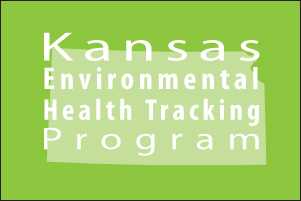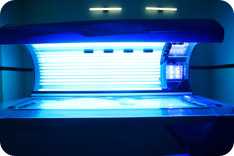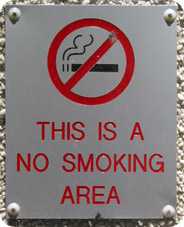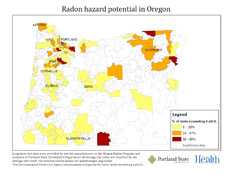Success Stories - Targeting Prevention
California - Preventing Exposures to Nitrates in Drinking Water NEW
![]()
What is the problem?
Nitrate-contaminated drinking water can lead to serious illness in infants. Also, exposure to nitrates has been associated with certain cancers and adverse reproductive outcomes, including various birth defects. In California, some communities are at higher risk for having nitrate contamination in their drinking water. Because there was no statewide digital map of the areas served by drinking water systems, identifying communities at higher risk for nitrate exposure has been difficult. Moreover, the state had no central location for gathering this information.
What did Tracking do?
The California Tracking Program created a Web-based tool to help water systems create digital maps of the areas they serve. Prior to this effort, many systems only had paper maps. The tracking program's water tool has received information for public water systems that serve almost 90% of the state's total population. With this information, users can also identify communities that may be using unregulated private wells, which are also at high risk for nitrate contamination.
Improved public health
The University of California at Davis, on behalf of the state Water Resources Control Board, used data from the water tool and other sources in a report to the state legislature. The report identified communities most exposed to nitrate contamination in drinking water and proposed potential remediation solutions. Findings and recommendations in the report have led to prevention, monitoring, training, and funding activities in high risk areas.
California - Identifying Exposures to Air Pollution from Traffic NEW
![]()
What is the problem?
Air pollution from traffic is associated with a variety of health problems. Researchers and public health workers use data on traffic to estimate air pollution and to look at the relationship between traffic pollution and health. However, traffic data can be difficult to access and use.
What did Tracking do?
The California Tracking Program developed a traffic tool to make it easier to access and use CalTrans traffic data for public health activities. People can use the tool to calculate a range of traffic features, such as the average number of vehicles traveling near a location per day. Users of the tool can find out how much traffic passes through any geography, such as a zip code, neighborhood, or another custom area around a specific address. Researchers can compare data from the traffic tool with health data from the CA Tracking Network or other sources to understand better the possible links between air pollution and health.
Improved public health
Several agencies have used the traffic tool to protect and improve public health. For example, the Bay Area Air Quality Management District uses the traffic tool to determine if a proposed project will increase risks of exposure to traffic pollutants. And the CA Environmental Protection Agency used the traffic tool to identify locations more likely to be exposed to pollution from traffic. The agency added this information to its screening tool which identifies communities likely to be affected most by environmental exposures and poor health.
California - Heat Wave Preparedness
![]()
What is the problem?
During the California 2006 heat wave, there were 140 confirmed deaths and an additional 515 suspected deaths due to extreme heat. An estimated $133 million in health-related costs was attributed to the heat wave, along with an estimated $500 million in agriculture-related costs from the loss of livestock. Heat waves have and will continue to impact all regions of California, including urban, rural, inland, and coastal areas. In California, heat waves are expected to become longer and more frequent over time.
What did Tracking do?
The California Environmental Health Tracking Program worked with the Bay Area National Weather Service (NWS) regional office to conduct a study to determine if heat alerts accurately predicted times when people suffered the most heat illness. NWS monitors temperature and issues heat alerts. The heat alerts serve as triggers for cities and counties to take preventative action, such as opening cooling centers where the public can gather for life-saving relief from the heat. The California Tracking Program showed that heat-related emergency room visits peaked immediately following heat alerts for the San Jose area and subsided when the heat alerts were discontinued. Due to budget cuts, the City of San Jose wanted scientific evidence from NWS to show there was a need for cooling centers during heat waves. Without this proof, decision-makers would not approve the opening of cooling centers as part of the city's heat alert response plan for the upcoming summer.
Improved public health
NWS presented the California Tracking Program study findings to City of San Jose decision-makers. Based on this evidence, the city decided to allow cooling centers to open as part of the city's heat alert response. The California Tracking Program is partnering with NWS to conduct similar studies for other regions in California, including Los Angeles. This information will help cities to make decisions about heat wave preparedness policies and help NWS refine its heat alert system for each region.
Connecticut - Improving evaluation of asthma programs

What is the problem?
Asthma is an ongoing concern for many Connecticut residents, especially those living in urban areas. Tracking the rates of stays in the hospital because of asthma is key to assessing the success of public health interventions.
What did Tracking do?
The Connecticut Tracking Program developed a part of the state tracking network just for asthma. This section includes data from the state asthma program and from hospitals across the state. Users can view real-time rates for asthma-related hospital stays by ethnicity, gender, race, and county.
Improved public health
Thanks to the Connecticut Tracking Program, complete, user-friendly asthma data for the state are available in one place for the first time. Other health department programs in Connecticut now have access to asthma data that can help them more readily evaluate their asthma prevention and control activities in less time.
Florida - Fostering Asthma-friendly Schools NEW

What is the problem?
In 2012, about 20% of middle and high school students in Florida had been diagnosed with asthma. Asthma is a leading cause of missed school days. Uncontrolled asthma can affect students' grades and limit their involvement in school activities. Schools can play an important role in helping students control and manage their asthma. For example, they can limit students' exposure to outdoor air pollution that can trigger asthma attacks. Schools can use the U.S. Environmental Protection Agency's free AirNow.gov alerts to plan activities when air quality is poor. However, the Florida Tracking Program found that few schools use the alerts.
What did Tracking do?
The Florida Tracking Program partnered with the state asthma program to increase the use of the AirNow alerts across the state, especially in schools. Together, they created a process to recognize schools and childcare centers that support asthma-friendly environments. Schools must register to receive AirNow alerts, and meet other criteria, to be considered for this voluntary recognition.
Improved public health
By April 2013, 7 childcare centers and about twelve K-12 schools had received the Asthma-Friendly School Recognition. As more schools are recognized, thousands of children will be attending schools that are better prepared to deal with poor air quality conditions. This will lead to healthier environments for kids with asthma in Florida.
Florida - Consuming fish safely: Mercury biomonitoring project
![]()
What is the problem?
Mercury is a toxin that occurs in the environment naturally and as a result of industrial pollution. Methylmercury is a form of mercury found in some fish and shellfish. It poses a risk to people who consume certain types of fish and shellfish. The greatest risk is to women of childbearing age and to children, who should not eat certain types of fish. Mercury can damage the nervous system of young children and developing fetuses.
Human exposure to mercury through fish consumption is a growing concern in the United States. Areas with high mercury emissions from coal-fired power plants and that have populations who frequently consume fish are of most concern. To help people eat the proper amount and species, they need accurate information about how much and what types of fish to consume.
What did Tracking do?
Researchers evaluated fish eating patterns among women of child-bearing age in Duval and Martin Counties, their research also included mercury biomonitoring. Participants completed a survey about their fish eating habits, knowledge of fish consumption advisories, pregnancy status, demographic and socio-economic information, and mercury exposure history. And each participant provided a scalp hair sample for mercury analysis.
Results showed that women of child-bearing age in Duval and Martin Counties consume more fish than their counterparts in other areas of the United States and that their hair-mercury levels are higher than the participants of the study who do not consume fish. Because of the low local awareness of fish advisories, increased education is needed about the advisories and about mercury exposure among at-risk populations in Duval and Martin Counties.
Improved public health
The Florida Tracking Program created the Fish for Your Health Wallet Card. It contains information about what types and amounts of fish to eat. It encourages women to enjoy the health benefits of certain kinds of fish but also avoid unsafe amounts of mercury. The card lists:
- Species of fish by different categories of mercury content, and
- Suggested amounts of fish to eat each week.
The Florida Tracking Program distributes the wallet cards to county health departments, state fish markets and grocery stores, and to the Florida Medical Association (FMA). The FMA sends the wallet cards to local branches and to physicians' offices.
Kansas - Mapping childhood lead poisoning data

What is the problem?
Lead is a heavy metal toxin that is commonly found in our environment. Lead affects the health of many, especially children. The most common cause of childhood lead poisoning is the deterioration of lead-based paint surfaces in homes. Nearly 70% of homes in Kansas are at risk due to the use of lead-based paints. Blood lead levels (BLLs) as low as 5 micrograms per deciliter (ug/dL) are associated with harmful effects on children's learning and behavior. In Kansas, a child is considered poisoned with a BLL of 10 ug/dL. Hundreds of children are poisoned by lead in Kansas each year. However, many children in the state are not screened for lead.
What did Tracking do?
The Kansas Tracking Program will partner with KDHE's Healthy Homes Program to evaluate data from the childhood blood lead program. Through mapping, the Kansas Tracking Program will be able to illustrate the areas of the state where BLLs are high and a large number of older homes are located.
Improved public health
Using the evaluation, the Kansas Tracking Program will be able to define objectively the scope of both childhood blood lead screening and childhood blood lead poisoning. This will provide valuable information to public health professionals to conduct targeted health outreach. The goal is to increase the number of children that are screened for lead in their blood and decrease the number of children with blood lead poisoning.
Kansas - Partnering with Kansas Radon Program
What is the problem?
Radon is the leading cause of lung cancer in non-smokers and the second leading cause of lung cancer overall. It is estimated that as many as 200 cases of lung cancer per year may be related to prolonged radon exposure in Kansans. Radon typically moves from the ground under and around a home through cracks and other holes in the foundation. The Kansas Radon Program's database of tests has more than 47,000 measurements, and 40% of them are at or above the U.S. Environmental Protection Agency's action level.
What did Tracking do?
The Kansas Tracking Program will assist the Kansas Radon Program to analyze data and discover trends that indicate increased risk to public health. The results of this analysis will be made available to all citizens through the Kansas Tracking Network.
Improved public health
This information will increase public awareness of radon. It will also allow public health officials and the public to make informed decisions and take action to prevent exposure and reduce the risks associated with elevated radon levels.
Maine - Educating Residents about a New Risk for Carbon Monoxide Poisoning NEW
![]()
What is the problem?
In May 2012, three adults died from carbon monoxide (CO) poisoning after their off-roading vehicle became stuck in a mudbog in central Maine. While CO poisoning has long been a public health concern in Maine, off-roading was not among the list of potentially risky activities included in the state health department's public education efforts about preventing CO poisoning.
What did Tracking do?
Immediately responding to the deaths, Maine Tracking Program staff used data from their case-based CO poisoning surveillance system to identify a similar event that occurred in 2010. Using information about the two events, the tracking program identified off-roading as a more significant risk for CO poisoning than previously thought. Within a day of the 2012 deaths, tracking staff began educating reporters about CO poisoning, providing them guidance about preventing CO poisoning while off-roading to include in the ongoing news coverage of the deaths.
Improved public health
A few weeks following the deaths, the tracking program issued its annual advisory about preventing CO poisoning during summertime activities. This advisory included specific CO poisoning prevention advice about off-roading. These recommendations are now part of Maine's standard health advisory issued each spring.
Massachusetts - Collaborating with federal agencies to improve public health
![]()
What is the problem?
The U.S. Environmental Protection Agency (USEPA) asked the Massachusetts Tracking Program to evaluate lead levels in surface soil at the former Agawam Sportsman Club site. EPA wanted to find out whether the amount of lead in the soil posed a risk to young children or to others who used the area. High amounts of lead in surface soil can pose serious health concerns if exposures occur, especially to young children.
What did Tracking do?
The Tracking Program evaluated surface soil sampling results for the site. The tracking program also looked at available data on blood lead levels (BLLs) in children who lived or had lived near the site.
Lead was detected in the soil in amounts higher than EPA screening levels. But, the actual BLLs among the tested children were low. The tracking program also found that the number of cases of high BLLs in the area of the former sportsmen's club was similar to other parts of the town.
Improved public health
Though BLLs among children living near the site were not as high as expected, the EPA took action to reduce possible contact with the contaminated soil. Specifically, the EPA removed soil where needed and installed soil-erosion control devices next to a nearby stream.
Minnesota - Preparing for Extreme Heat Events NEW

What is the problem?
Extreme heat events, or heat waves, are the most common cause of weather-related deaths in the United States. In Minnesota each year, heat-related illnesses lead to hundreds of emergency department visits and hospital stays. Planning successful prevention and response activities for extreme heat events can be difficult for public health agencies when they do not have a clear picture of who is most at risk.
What did Tracking do?
The Minnesota Tracking Program analyzed data on heat-related illnesses and deaths to inform health professionals about groups most at risk during extreme heat events. They found surprising new information, including:
- 15- to 34-year-olds are an at-risk age group, in addition to people aged 65-years and older.
- Rates of hospital stays and emergency department visits were higher in greater Minnesota compared to the 7-county metropolitan area that includes the Twin Cities.
State and local health professionals used the tracking data to develop and update maps showing areas with at-risk populations. The maps show which areas need support to prepare for heat waves.
Improved public health
Health agencies across Minnesota now have a clearer understanding of the people most at risk for illness or death from extreme heat. Each summer, they use the data to focus outreach and planning efforts. Then they use the data to evaluate the effectiveness of their prevention and response efforts and to monitor trends of heat-related illness over time.
Minnesota - Preventing Melanoma NEW

What is the problem?
Melanoma is the most dangerous form of skin cancer. It is one of the most rapidly increasing cancers among Minnesotans. CDC estimates that exposure to ultraviolet (UV) light causes 65-90% of all melanoma. UV light comes from the sun but can also come from tanning beds. Despite the risks for melanoma, tanning bed use remains common in Minnesota.
What did Tracking do?
The Minnesota Tracking Program published interactive maps and charts on their state tracking network showing trends and geographic patterns of melanoma across the state. They also collaborated with the state cancer registry to add county-level melanoma data to MN County Health Tables, a resource used by state and county public health officials to guide program planning and evaluation.
Improved public health
Since making melanoma data easy to find and use, tracking program staff have worked with state programs and other partners, such as the American Cancer Society of MN and the MN Cancer Alliance, to use tracking data to support program and policy initiatives to prevent melanoma. For example, these partners identified reducing the use of artificial UV light for tanning as a key objective in Cancer Plan Minnesota: 2011-2016, a framework for preventing and controlling different types of cancer. In addition, tracking data will be used to evaluate the effectiveness of melanoma prevention program and policy initiatives over time.
Minnesota - Evaluating Indoor Smoking Ban Legislation to Protect Residents from Secondhand Smoke NEW

What is the problem?
Secondhand smoke, also known as environmental tobacco smoke, causes cancer and other health problems in both children and adults. To help reduce exposure to secondhand smoke, Minnesota passed Freedom to Breathe legislation in 2007. The legislation banned smoking in almost all indoor public places and indoor work sites, including bars and restaurants. In 2011, some legislators worked to repeal the legislation.
What did Tracking do?
The Minnesota Tracking Program maintains data on secondhand smoke among nonsmokers for the state. Tracking staff analyzed state data to determine if Freedom to Breathe legislation helped reduce residents' exposures to secondhand smoke. Tracking staff found that since 2007, exposures to secondhand smoke decreased among non-smokers. In addition, children's exposures decreased by 20% and adults' exposures decreased by 25%.
Improved public health
Freedom to Breathe legislation remains in place because the tracking program demonstrated that the legislation was associated with a decrease in exposures to secondhand smoke and because there is strong support to keep the smoking bans in Minnesota. In addition, tobacco prevention programs and others have been able to use the tracking data to plan more effective smoking cessation and awareness activities.
Oregon - Increasing Awareness of and Testing for Radon NEW
![]()
What is the problem?
Radon is the second leading cause of lung cancer and is the leading environmental cause of cancer deaths in the United States. Radon is a colorless, odorless, tasteless radioactive gas. Testing is the only way to know if radon levels are high in a building or home. In 1993, the U.S. Environmental Protection Agency identified Oregon as having low to moderate levels of radon. However, recent data show that some areas of the state have high radon levels. The state needed more accurate data on radon hazards to promote testing.

What did Tracking do?
The Oregon Tracking Program and partners developed maps showing radon hazards for areas smaller than counties. Tracking staff used these maps to support public education to encourage in-home radon testing during January 2013, Radon Action Month. They published the radon maps on the health department's Radon Program web pages and on Oregon Tracking's Facebook page. They sent news releases to media outlets announcing the maps and providing information about radon testing.
Improved public health
Television news coverage and two front-page articles in The Oregonian newspaper about the maps helped raise public awareness of radon hazards and encourage radon testing. Following the media coverage, monthly average visits to the Radon Program's web pages tripled. Data from the American Lung Association (ALA) of Oregon showed that they sold nearly 300 test kits during the first day the front page Oregonian article ran. Within three days, ALA sold more radon test kits online than they did in the entire year of 2012. Increases in radon testing likely will lead to more people taking steps to decrease the amount of radon they come in contact with.
Pennsylvania - Asthma school project(2004-2005 school year)
![]()
What is the problem?
Analysis showed that the Bradford Area and Oley Valley school districts had the highest prevalence of reported asthma for six school years between 1997 and 2003.
What did Tracking do?
School nurses tracked asthma cases at all 501 public school districts in Pennsylvania. The project then tracked all students with asthma in the two districts that had the highest prevalence of asthma cases. The project also evaluated environmental factors at the schools but no unusual patterns or links to the schools were identified.
Improved public health
Pennsylvania's Tracking Program uses information from this school-based asthma surveillance project to target prevention strategies. They provided prevention strategies and educational materials on asthma and asthma triggers to the public, schools and communities. People can use these materials to reduce exposure to potential environmental risks and triggers and increase their knowledge and awareness regarding asthma.
South Carolina - Protecting Adults from Lead Exposure NEW

What is the problem?
Even though lead poisoning often is considered to be a children's health issue, hobbies or jobs can put adults at risk. Exposure to high levels of lead can damage the brain, nerves, and kidneys. Symptoms of lead exposure may not be noticed until blood lead levels are very high. The Occupational Safety and Health Administration requires blood lead testing for some workers to ensure that they are not overexposed to lead.
What did Tracking do?
The South Carolina Tracking Program built and maintains a database of blood lead testing results for the state. They initiate follow up for cases of elevated lead results in children. And, they partner with the SC Occupational Safety and Health Administration (SC OSHA) to monitor adult blood lead levels. Tracking staff create quarterly reports on elevated adult blood lead levels. SC OSHA uses the information in these reports to decide where to conduct targeted inspections of worksites where employees' blood lead levels were above regulation limits.
Improved public health
The SC Tracking Program identified 89 cases of elevated blood lead levels in occupational settings in 2012. As a result, SC OSHA inspected four workplaces and issued citations containing 15 violations. Some worksites were required to pay fines and all were required to reduce lead exposures. Workers in these locations now have safer work environments where their risk for lead exposure has been decreased or eliminated.
- Page last reviewed: January 3, 2014
- Page last updated: June 24, 2013
- Content source:


 ShareCompartir
ShareCompartir